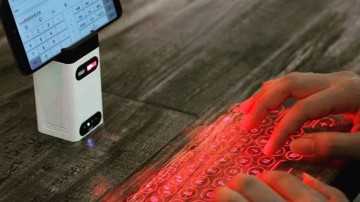
Virtual Keyboards are just another illustration of today’s computer sensation of being smaller and faster. Computing is nowadays not restricted to desktops and laptops, it has discovered its path into mobile gadgets like palmtops and even cell phones.
The virtual keyboard technology uses sensor technology and artificial intelligence to let users function on any flat surface as if it were a keyboard.
Virtual Devices have created a flashlight-size device that launches an image of a keyboard on any surface and then people input information by typing on the vision or image.
The gadget detects activity when fingers are pressed down. Those movements are measured and the device accurately specifies the intended keystrokes and decodes them into text. It uses light to project a full-sized computer keyboard onto any surface and disappears when not in usage. The translation process also uses artificial intelligence. Once the keystroke has been converted, it is sent to the portable device either by cable or via wireless.
The company's Virtual Keyboard is developed for anyone who's become frustrated with trying to put data into a handheld but doesn't want to carry a notebook computer around. There is also the provision for a pause feature to avoid decoding nonessential hand movements function so that users can stop to eat, drink etc. Combination key presses ("chords") of five main and two extra control keys allow users to type at 25-60 words per minute, with possibly greater speeds reached through the use of abbreviation expansion software. Virtual keyboards crack the issue of sore thumbs that can be caused by typing on the tiny keyboards of various gadgets like PDAs and cell phones. They are pointed to satisfy the needs of mobile computer users stumbling with clunky, tiny, or absent keyboards. It helps you to prevent RSI injuries. The Virtual Keyboard uses an extremely durable material which is incredibly easy to clean. It will operate with all types of Bluetooth-enabled devices such as PDAs, smartphones and wearable desktops.
This system comprises three modules,
- The sensor module
- IR-light source and
- The pattern projector
ADVANTAGES
- You do not need a surface for typing. You can even type in plain air.
- It can be helpful in places like operation theatres where low noise is vital.
- The typing does not demand a lot of energy. So it reduces the pressure on wrists and hands.
- No driver software is necessary, it can be used as a plug-and-play device.
- High battery life. The standard coin-sized lithium battery lasts about eight months.
DRAWBACKS
-
The virtual keyboard is hard to get, and tuff to use. Since it involves typing in thin air, it needs a little practice. People who are good at typing can use a virtual keyboard properly.
-
It is very costly ranging from 150 to 200 dollars.
-
The space in which the projected keyboard is used should not be very bright so that the keyboard is properly visible.



.webp)
.jpg)

.webp)
